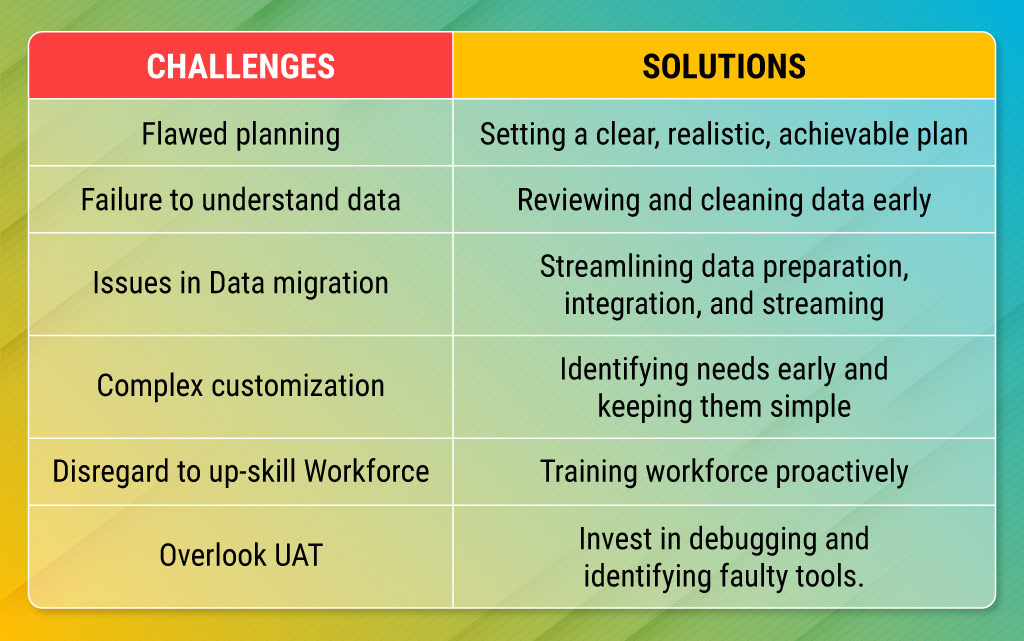Every organization intends to strongly engage with its customers through greatly aligned sales strategies, which are made possible with exemplary CRM software. This brings us to Salesforce – the all-in-one CRM tool that can streamline multiple business areas like sales, marketing, customer relationship management, and service from a single platform.
Learn more about why it is a must-have power tool for your business.
Now, setting up a new CRM in a growing company is certainly not a walk in the park. To execute it to the tee, you will need detailed planning, great coordination, and full commitment from the executive team. Also, to ensure smooth implementation, it is crucial to consider the needs of all the sections of your organization.
8 Reliable Strategies for Your Salesforce Implementation Project

If you are looking for advanced strategies and a practical guide to carry out the Salesforce CRM integration, look no further.
In a crucial phase like this, a Salesforce partner can help with expert-level guidance and nail down the entire process. But first, we have put together 8 strategies that you must know to successfully implement Salesforce CRM in your company.
1. Planning is the key
“Before anything else, preparation is the key to success.” – Alexander Graham Bell.
A well-thought-out plan is the first step on the path to success. Hence, devising a workable plan and allocating resources properly are vital. Working out who does what is an essential step in the process. So building a project implementation team is the next step. An organized project team looks like this,
A Chief Sponsor
They are responsible for the end-to-end process as well as overseeing the strategy and successful execution of the project.
A Project Head
They own the project completely. The major difference between the sponsor and the project head is the vast technical knowledge and understanding of the business process. IT Managers and CIOs are the best bet for the position.
A System Administrator
They handle the Salesforce configuration on a day-to-day basis. The admin takes care of securing, maintaining, troubleshooting and anything that requires detailed scrutiny.
A Power User
They encourage user adoption and lay the grounding for the training of end-users.
A trainer might be helpful if the end-users need a demonstration. Apart from the key people, a Salesforce expert can be instrumental in driving the whole procedure.
So, a strategic Salesforce partner is the go-to person when you are on the fence about most implementation ideas. An expert can rescue you from an impending mess of time wastage and loss of money.
2. Refining data
Now is the right time to kick start data cleansing and mapping. When migrating from one CRM to another, the biggest hurdle is data quality. That is why data must be understood, cleaned up and mapped to smoothen the data migration process. This step involves technical knowledge. If data mapping is not addressed in the initial stages of the implementation, it becomes quite a challenge in the meantime.
3. Adopting a precise implementation approach
There are two major approaches in the implementation process:
- the conventional waterfall model, or
- the trending agile model.
Conventional Waterfall model
A classical model with a linear and sequential approach towards the software development life cycle. This model has multiple phases and the output of one phase will be the input of the other without overlaying of phases. This is a well-defined approach that is easy to use and understand. However, it’s not a convenient method for a complex project and may deliver uncertain effects at the later stages.
Agile Model
The latest approach with an iterative and unstructured approach, which supports reviving of the project scope of the Software development life cycle, as the need arouses. The complete development process is split into multiple deliverables and monitored. People who are used to the former method may find difficulties fitting into the Agile method. But this method handles complex projects with ease and gets the testers & developers together till the end of the project.
Though small and medium-sized companies adopt the waterfall model initially, they gradually turn to the scrum/agile model towards the release. But it is entirely up to the organization to customize this option. However, the sequential cloud integration by the Salesforce Partner increases productivity by reducing unnecessary hindrances. So, it is important to identify when to outsource to a Salesforce integration partner.
4. Creating a Project Timeline
Any organization that establishes a timeline and adheres to it is on the way to progress. The timeline should be detailed and have enough scope or flexibility to accommodate future alterations or complications. It helps keep the project on track from the start.
So, the next step is to set up an agile project timeline that consists of brief iterations of the design, development, and execution for smaller sets of specifications. The Project Head assures the whole process sticks to the timeline.
5. Tailoring the CRM to company-specific business process
Now that the crucial initial steps are completed, it is time to work your way up to customizing the CRM. One of the best ways to customize is with a Salesforce partner, as it is tricky to deal with the workload involved in the process. The process draws in permissions and limitations for users, determining the reporting functionality, creating custom fields, deciding if you use Lead functionality, generating standard or customized reports, etc.
6. Rolling out Salesforce CRM
If you get the configuration right, the next step in the process is going live. A possible solution to de-risk the employees with data overload is a phase-by-phase approach to help users get familiar. Thus, making the rollout effortless. Not to forget the phase of User Acceptance Testing to deploy an error-free CRM. The documentation of the pain points and focus on areas of improvement is the key to better results.
Eventually, always stay abreast of new releases, upgrading and customizing useful Salesforce add-ons and third-party vendors.
7. Invest time in training the employees
The implementation process is almost done, yet we are far from the end of the journey. The invaluable time spent in configuration is lost without training your company staff quickly and simultaneously to use the application. Scheduling training sessions, nominating a point of contact, and adding reference manuals guide the employees to make the best out of the CRM. Salesforce Trailhead is a viable option at this stage.
8. Resolving challenges
No implementation is perfect; it tends to encounter conflicts. The most common challenges every company faces during the implementation are listed below.

The organizations that constantly strive to improve and propose solutions to their bottlenecks tend to unlock greater prospects earlier than those that suffer setbacks.
Final words
Salesforce CRM is becoming a priceless pillar of rapidly growing small, medium-sized companies. Though the implementation process seems overwhelming, with guidance and support from the experts, getting up and running the CRM unleashes the power of an exceptional tool to streamline your business processes.
If you are looking for a Salesforce Consulting Partner to kick-start a smooth implementation process, get in touch with us.

